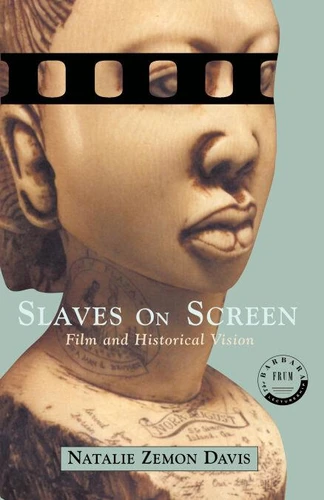Slaves on Screen. Film and Historical Vision
Par :Formats :
Disponible dans votre compte client Decitre ou Furet du Nord dès validation de votre commande. Le format ePub protégé est :
- Compatible avec une lecture sur My Vivlio (smartphone, tablette, ordinateur)
- Compatible avec une lecture sur liseuses Vivlio
- Pour les liseuses autres que Vivlio, vous devez utiliser le logiciel Adobe Digital Edition. Non compatible avec la lecture sur les liseuses Kindle, Remarkable et Sony
- Non compatible avec un achat hors France métropolitaine
 , qui est-ce ?
, qui est-ce ?Notre partenaire de plateforme de lecture numérique où vous retrouverez l'ensemble de vos ebooks gratuitement
Pour en savoir plus sur nos ebooks, consultez notre aide en ligne ici
- Nombre de pages176
- FormatePub
- ISBN978-0-307-36885-0
- EAN9780307368850
- Date de parution04/03/2011
- Protection num.Adobe DRM
- Taille3 Mo
- Infos supplémentairesepub
- ÉditeurVintage Canada
Résumé
People have been experimenting with different ways to write history for 2, 500 years, yet we have experimented with film in the same way for only a century. Noted professor and historian Natalie Zemon Davis, consultant for the film The Return of Martin Guerre, argues that movies can do much more than recreate exciting events and the external look of the past in costumes and sets. Film can show millions of viewers the sentiments, experiences and practices of a group, a period and a place; it can suggest the hidden processes and conflicts of political and family life.
And film has the potential to show the past accurately, wedding the concerns of the historian and the filmmaker. To explore the achievements and flaws of historical films in differing traditions, Davis uses two themes: slavery, and women in political power. She shows how slave resistance and the memory of slavery are represented through such films as Stanley Kubrick's Spartacus, Steven Spielberg's Amistad and Jonathan Demme's Beloved.
Then she considers the portrayal of queens from John Ford's Mary of Scotland and Shekhar Kapur's Elizabeth to John Madden's Mrs. Brown and compares them with the cinematic treatments of Eva Peron and Golda Meir. This visionary book encourages readers to consider history films both appreciatively and critically, while calling historians and filmmakers to a new collaboration.
And film has the potential to show the past accurately, wedding the concerns of the historian and the filmmaker. To explore the achievements and flaws of historical films in differing traditions, Davis uses two themes: slavery, and women in political power. She shows how slave resistance and the memory of slavery are represented through such films as Stanley Kubrick's Spartacus, Steven Spielberg's Amistad and Jonathan Demme's Beloved.
Then she considers the portrayal of queens from John Ford's Mary of Scotland and Shekhar Kapur's Elizabeth to John Madden's Mrs. Brown and compares them with the cinematic treatments of Eva Peron and Golda Meir. This visionary book encourages readers to consider history films both appreciatively and critically, while calling historians and filmmakers to a new collaboration.
People have been experimenting with different ways to write history for 2, 500 years, yet we have experimented with film in the same way for only a century. Noted professor and historian Natalie Zemon Davis, consultant for the film The Return of Martin Guerre, argues that movies can do much more than recreate exciting events and the external look of the past in costumes and sets. Film can show millions of viewers the sentiments, experiences and practices of a group, a period and a place; it can suggest the hidden processes and conflicts of political and family life.
And film has the potential to show the past accurately, wedding the concerns of the historian and the filmmaker. To explore the achievements and flaws of historical films in differing traditions, Davis uses two themes: slavery, and women in political power. She shows how slave resistance and the memory of slavery are represented through such films as Stanley Kubrick's Spartacus, Steven Spielberg's Amistad and Jonathan Demme's Beloved.
Then she considers the portrayal of queens from John Ford's Mary of Scotland and Shekhar Kapur's Elizabeth to John Madden's Mrs. Brown and compares them with the cinematic treatments of Eva Peron and Golda Meir. This visionary book encourages readers to consider history films both appreciatively and critically, while calling historians and filmmakers to a new collaboration.
And film has the potential to show the past accurately, wedding the concerns of the historian and the filmmaker. To explore the achievements and flaws of historical films in differing traditions, Davis uses two themes: slavery, and women in political power. She shows how slave resistance and the memory of slavery are represented through such films as Stanley Kubrick's Spartacus, Steven Spielberg's Amistad and Jonathan Demme's Beloved.
Then she considers the portrayal of queens from John Ford's Mary of Scotland and Shekhar Kapur's Elizabeth to John Madden's Mrs. Brown and compares them with the cinematic treatments of Eva Peron and Golda Meir. This visionary book encourages readers to consider history films both appreciatively and critically, while calling historians and filmmakers to a new collaboration.








